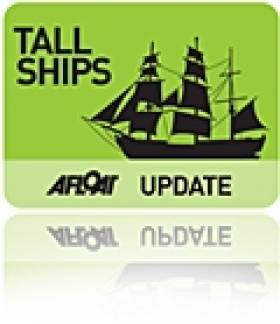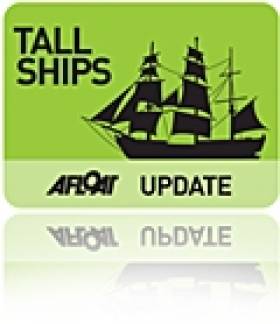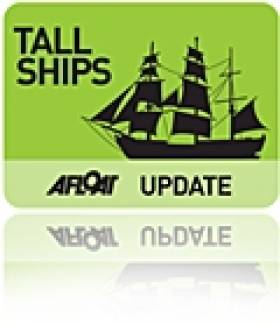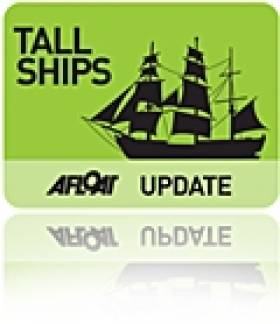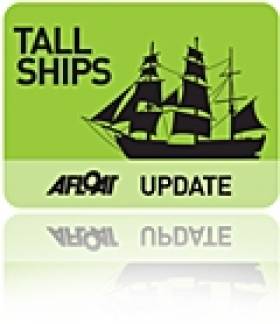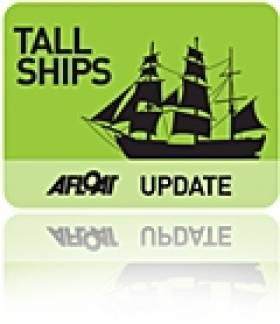Displaying items by tag: Tall Ships
Students Take Part in the Tall Ships Race
Marine Academy students from Plymouth in the UK are riding high on the crest of a wave - taking part in the 2011 Tall Ships Race.
Eighteen of the St Budeaux School's 14-19 year olds are involved in the international event which started in Waterford, Ireland and includes ports of call at Greenock, Scotland, Lerwick in the Shetland Isles and Stavanger in Norway before finally dropping anchor at Halmstad in Sweden at the beginning of August.
The 18 students successfully completed a rigorous selection procedure, which included an interview with Cremyll Sailing crew and a member of the marine science department at Plymouth University.
They were also given an insight into the realities of sailing by local round-the-world yachtsman Conrad Humphreys and had to demonstrate their enthusiasm and commitment on a three-day sail-training course during their last school holiday before finally becoming crew for a section of the race on the tall ship Moosk.
The first six sailed from Plymouth to Waterford where six more Marine Academy students will take over and race in the first leg from Waterford to Greenock. Once in Greenock, the crew will change again and the final six students will sail to Lerwick.
They join hundreds of other young people crewing ships from Russia, Belgium, Germany, Sweden, Lithuania, Poland, Norway, Denmark, Colombia, Spain and France.
The event tests the students' endurance and new found sailing skills. But it's not all hard work, they also have the chance to join in crew parties and parades through each of the host towns.
Judging by the young sailors messages on Facebook they're having a swell time. One Marine Academy student, Jack Howells, aged 14, from Beacon Park posted: "I just want to thank Cremyll Sailing for the opportunity of a life time, Waterford was amazing."
And student Lewis Harrison, aged 15, from Keyham (actually on board Moosk) said: "It's absolutely amazing! Breathtaking! We are sitting on the boat and there are thousands of people here - fireworks, horns tooting and bands playing. We are all much better mates than when we started out and even though most of us were sick through the Celtic Sea, the best bit has definitely been the sailing. There are ships from Spain and Norway next to us."
Peter Morris, manager, Cremyll Sailing said: "The Tall Ships is a great adventure. The atmosphere is electric and completely orientated to young people."
Helen Mathieson, academy principal, is delighted. She said: "The Tall Ships event is about 360 degree education - personal, social and leadership. It is empowering in its ethos and experience. The participation of our students demonstrates our commitment to the marine specialism - which is about understanding the vast range of careers, which make up this large and diverse sector, locally, nationally and internationally. "
Conrad Humphreys added: "I'm really pleased that together with the Marine Academy Plymouth we managed to secure these bursary places for these young people to have the chance to take part in the Tall Ships Race. This opportunity will provide them with a very rich experience on the sea, where they will develop team skills, confidence and trusting friendships. Our hope is that they become ocean ambassadors for the city of Plymouth and inspire others to take on the challenge."
Progress of Moosk and further information about the Tall Ships event can be found HERE
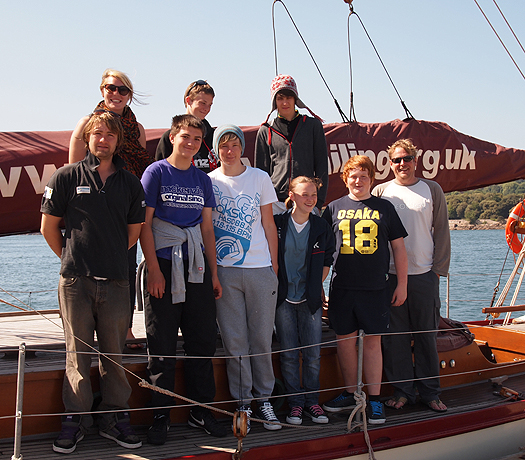
The Celtic Mist, the new flagship of the Irish Whale and Dolphin Group, was berthed in Waterford city for the Tall Ships weekend writes Shay Fennelly. Gifted to the IWDG in May 2011 by the family of a former Irish Prime Minister, Charles Haughey, who declared Irish waters a whale and dolphin sanctuary in 1991.
Celtic Mist left Waterford on Sunday morning in glorious sunshine on passage down the River Suir for the Tall Ships Parade of Sail off Dunmore East watched by thousands of people from the river bank at Passage east, Duncannon and Dunmore East.
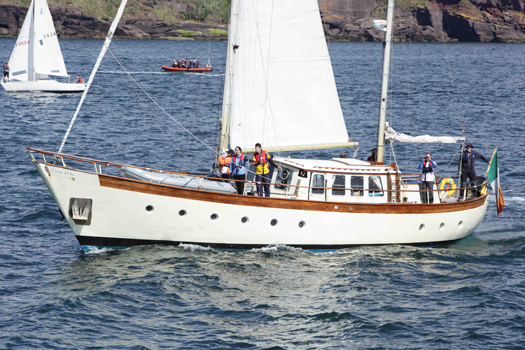
Ireland's only entry in the 2011 Tall Ships race from Waterford to Greenock Irish Whale and Dolphin Groups's research vessel Celtic Mist in the Tall Ships Parade of Sail off Dunmore East in Waterford. Photo: Shay Fennelly/Aquaphoto
The Tall Ships fleet was reviewed by Flag Officer Commanding Naval Service Commodore Mark Mellet and Sean Flood Sail Training Ireland (Board) and a Goodwill Ambassador for Sail Training International past the LE Aoife. Over 1200 young people, many who have never been to sea before, are onboard the 50 tall Ships sailing to Greenock.
On board Celtic Mist are Captain Fiacc Brolchain, Gary Davis, Eithne Griffith, Deirdre Slevin, Conor Ryan and trainees Siobhan Ardener (19) from Killarney, Co Kerry, and Keith Cleere (19) from New Ross, Co Wexford.
The race started slowly at 15.00hrs, five miles south of the Hook Lighthouse in 10 knots of wind and blue skies and headed for the Irish Sea to Scotland.
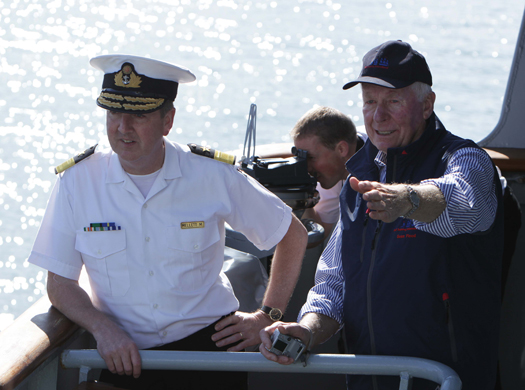
Flag Officer Commanding Naval Service, Commodore Mark Mellet (left) and Sean Flood Sail Training Ireland (Board) and a Goodwill Ambassador for Sail Training International on board LE Aoife reviewing the Tall Ships fleet as they passed off Dunmore East, County Waterford. Photo: Shay Fennelly/Aquaphoto
Famine Ship Needs €100K to Get Seaworthy
The Jeanie Johnston will need €100,000 to be made seaworthy again, it has emerged.
The three-masted barque - which not long ago sailed across the Atlantic - was missed at the weekend's Tall Ships festival, which attracted half a million visitors to Waterford.
But as the Sunday Independent reports, the ship is currently a stationary tourist attraction at berth in Dublin with her sails in storage.
Hopes are high, however, that the replica famine ship will be made ready as an ocean-going vessel in time for the Volvo Ocean Race in Galway next summer, not to mention the Tall Ships Races in Dublin next August.
"At the moment we are basically putting all the money coming in from the interactive tours, which have been very successful, back into the boat," said ship manager John O'Neill. "We are hopeful we will get the financial assistance we need to get the vessel back out to sea".
Tall Ships Will Sail to Dublin in 2012
It's official - the Tall Ships Races will be coming to Dublin in August next year!
As the Evening Herald reports, the successful four-day festival in Waterford this past weekend will be repeated in the capital from 23-26 August 2012, with up to 100 tall ships expected to sail up the mouth of the Liffey.
As keen readers of afloat.ie will already know, news of the Dublin event was published here back in March.
The event is hoped to attract more than a million visitors to the city, topping the 500,000 spectators who thronged Waterford from last Thursday to Sunday.
Young sailing trainees from Dublin will also have the opportunity of a lifetime to work on board the vessels.
Racing Round Up: Lasers, E Boats, Puppeteers,DBSC, VDLR, Royal Cork, Cove and Sailor of the Month
In Cork Harbour 'Mid-Summer Madness' regatta attracted 40 Boats. We have the photos. There was a Fun Time for Cruisers at Cove Sailing Club's 'At Home' Regatta.
Galway's Martin Breen is June's Sailor of the Month and the Waterford Tall Ships Parade of Sail Photos are here.
Reasons to be cheerful? You bet. Click here to read how Dublin Bay sailors celebrate these wins.
Tall Ships Parade of Sail Photos 2
More of Gary O'Mahony's images of the Tall Ships fleet leaving Waterford.
Waterford Tall Ships Parade of Sail Photos
Thousands bade farewell to the 45 tall ships departing Waterford this afternoon. Afloat Photographer Gary O'Mahony captured the scene. Scroll down for the photos.
It's Official: Third Time Tallships for Waterford
Scenes of the tallships moored alongside the north and south quays and the surrounding festivities are captured by Gary O'Mahony. SCROLL DOWN FOR PICS.

The Columbian Navy's Sailing Training Ship ARC Gloria. Photo: Jehan Ashmore
This is the second year in which the city has been the host port of the Tall Ships Race and the prestigious event is to return for a third time. The next occasion has not been confirmed but it would be several years away according to Sail Training International, the organisers of the famous race.
Lord Nelson Heads for Waterford
As the Tall Ship STS Lord Nelson nears Carnsore Point off Wexford this evening the barque will be one of the many vessels participating in the Waterford Talls Ships Races Festival, writes Jehan Ashmore.
Joining Lord Nelson are three other UK entrants, they are the Jean de la Lune, Pelican of London and Royalist now celebrating her 40th anniversary. Together these tallships belong to the 'A' class vessels, the largest of the tallships. The impressive array of A class vessels includes four ships alone from The Netherlands with the Astrid, Eendracht, Europa and Wylde Swan, a schooner built in 1920.
From Norway is the fully rigged tallship Christian Radich and Sorlandet. The Poles are coming with their Pogoria. Neighbouring Russia are sending their impressive 108m long Mir which has 26 sails and has a 200-strong crew though the 1987 built vessel can be sailed with just 30. The final A class entrant is from outside Europe, the Columbian 1,300 tonnes Gloria, a three-master of over 60 metres long.
In addition to this exciting line-up are the 'B' and 'C' class which in total brings 45 tallships of all shapes and sizes to the quays of the River Suir. The crystal city will be host to over 1,000 trainess and over 400 professional crew who will take part in the colourful 'Crew Parade' held on Friday. For a full list of tallships and accompanying photos go to www.waterfordtallshipsrace.ie/the-race/the-tall-ships/
The spectacle of the festival will culminate in the early hours of Sunday when the fleet departs the city and heads downriver with a 'Parade of Sail' in the estuary of Waterford Harbour. As the tallships pass offshore of Dunmore East, this will mark the start of the first race-leg to Greenock.
The famous race is organised by Sail Training International (STI) a charity established to harness sail training to develop and educate young people, regardless of nationality, culture, religion, gender or social background.
The STI can trace its roots with the creation of the Sail Training International Race Committee which organised the first race of sail training tall ships in 1956. Their website is www.sailtraininginternational.org/
However, from June 30-July 3, when the ships are moored in Waterford and when we do go down to the quays to see them, the public must be aware of the dangers associated with closeness to water and be actively responsible for their own safety and that of their children! No doubt, every precaution will be taken to ensure as far as is practical that safety precautions and rescue equipment are in place for your protection. However, this does not alter the responsibility we have for our own personal safety and that of our children at all times.
For this reason, the host port team for the Tall Ships visit will have in place comprehensive safety and management arrangements, coupled with regimes for rescuing people in the event of a water related accident. Again, this in no way relieves any visitor to the quaysides of responsibility for their own personal water craft and all on board and the safety and care of all.
Therefore:
Do not go too near to the quayside edges; remember falling down between a quay and a boat is one of the most difficult places to get rescued from.
If anxious to see or visit a particular Tall Ship, don't push those in front of you towards the water's edge. Take your time; the ships are in Waterford over three days.
If going on board any boat or ships, never jump from the quay onto the boat, or indeed from boat to boat. Always use a gangplank if available. If not, you must take extreme care when crossing.
Excessive alcohol and water do not mix. Therefore, visitors to the quaysides should ensure that they do not have excessive drink taken.
Those who invite people on board their vessels, regardless of size, must take a responsible approach to the availability of alcohol - bearing in mind the inherent dangers of being on board a vessel at all times under the influence of any alcoholic drink.
Do not climb on or over any railings, walls or other barriers that protect the quays from the water.
On smaller vessels, there is a definite legal requirement in relation to wearing life-jackets and one should be familiar with this requirement.
Ringbuoys and other lifesaving equipment placed on the quaysides should not under any circumstance be interfered with, they are provided to save lives in the event of someone falling into the water.
For those afloat, MARINE NOTICE 047 of 2011 has significance and all should make themselves aware of this important document which covers all recreational craft afloat and the responsibilities with regard to their vessel.
In conclusion, it behoves every person to ensure that The Tall Ships Races will be a safe and memorable occasion to visit Waterford with its noble quays, a once-in-a-lifetime spectacle to have seen and enjoyed by all who visit the city and port.
Calling "112" or "999"- Ask for the "Coast Guard".
If you see someone in trouble in the water (or you think someone is in trouble) don't hesitate to dial one of the emergency numbers (112 or 999) and ask to be put through to the "Coast Guard". When you are connected to the Coast Guard, give a brief description of what you saw and the Coast Guard will decide on the necessary action to take.
Remember! Always ask for the Coast Guard, as this will avoid any unnecessary delay by being connected to the wrong service particularly if someone is in trouble in the water. During the Tall Ships visit to Waterford should a telephone not be available ask any Garda, Civil Defence Officer or other steward on duty for help.



























